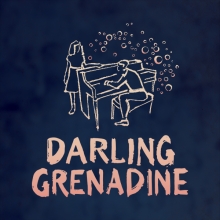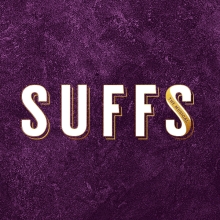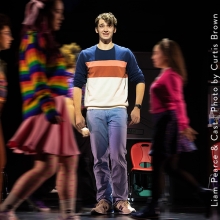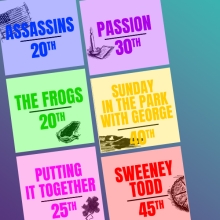
Full Synopsis
The show starts with an African-American woman sitting on a bench, waiting for a late bus in 1955. While she sits, a memory stirs. The Interlocutor introduces the two archetypal minstrel show characters, Mr. Tambo and Mr. Bones, who will play a variety of characters. Using humor typical of minstrel shows, the three set the stage for an evening of song and dance ("Hey, Hey, Hey, Hey"). The story is that of the Scottsboro Boys, who are sitting in a minstrel circle as the Interlocuter introduces them. One boy, Haywood, asks if they can tell the truth this time, and the Interlocutor assures him they can.
The scene transitions to a boxcar that is heading for Memphis. The Scottsboro Boys — Clarence, Andy, Roy, Haywood, Olen, Ozie, Charles, Eugene and Willie — are all aboard, looking for work, opportunity and freedom ("Commencing In Chattanooga"). Suddenly, the train slows. A white sheriff, played by Mr. Bones, confronts the boys; word was sent that there was fighting on the train between a group of white boys and "colored" boys. Deputy Tambo arrives with Victoria and Ruby, two white women played by Charlie and Ozie in drag. It seems that the girls were caught hitching a ride without paying. In order to get out of trouble, Ruby and Victoria claim a group of young Black men raped them ("Alabama Ladies"). The Interlocutor, as the Boss Man, confronts Haywood and the boys about the girls' story. Haywood insists that it is not the truth. Sheriff Bones is enraged that anyone would dare challenge the honor of Alabama womanhood. A lynching seems imminent, but The Interlocutor stops them, saying that the Boys should have a proper trial. Sheriff Bones and Deputy Tambo lead the boys to the County Jail.
Once the boys are in prison, Sheriff Bones roughs up Haywood. He gives him a pad and pencil and tells him to write the boys' names. Olen, afraid for his life, starts saying that he'll confess and tell them who did it. Clarence tells Haywood to write down their names. It becomes apparent that most of the boys can't write. Roy picks up the pad, and the other boys introduce themselves to each other. Willie reveals that he stole Sheriff Bones' badge. The boys begin to realize the harsh reality of their situation: they are likely to be condemned, even with a trial. They start to fight each other, and the Interlocutor enters to settle them down. He tells them that a crowd has assembled outside... and that they are in a lynching mood. The Interlocutor then ushers the boys into their trial.
The boys return to the minstrel circle. This time it is in the courtroom. The Interlocutor presides as the judge, with Mr. Tambo as the boys' white lawyer... who is clearly drunk. Mr. Bones plays the old, white prosecutor. Haywood takes the stand and states their innocence, but the trial is clearly fixed ("Nothin'"). The Interlocutor condemns them to die in the electric chair. The boys are taken to prison, de-loused, stripped of their clothes and given prison uniforms.
The guards taunt Eugene, the youngest boy, who doesn't even know what rape is, about the smell coming from the room with the electric chair. Roy and Willie bring the Interlocutor's chair front and center and play revived victims of the chair who dance with Eugene ("Electric Chair"). Eugene wakes from the nightmare, surrounded by the others in the prison cell. The boys exhibit various levels of fear and defiance about their situation. Roy shares a bit of a letter he wrote to his and Andy's mother. It reminds Haywood of home ("Go Back Home").
A Preacher comes to deliver Haywood his last rites. The guard is about to usher him to the chair, when the Interlocutor stops the action. The Supreme Court has decreed that the boys did not have a proper lawyer; they will have to have another trial. Haywood and the Boys are relieved and joyous for this second chance ("Second Chance"). They engage in a "challenge dance," where Haywood wins, and Clarence gives him the Sheriff's star as a prize. The guards are not amused and take Haywood to solitary confinement. The other boys continue to celebrate.
While Haywood is in solitary confinement, Roy "teaches him his letters" by showing him how to draw them in dirt sprinkled on the floor. Roy gives Haywood the pencil and pad, and Haywood is released from solitary. The Interlocutor asks him what he has been writing, and Haywood relates the tale of his cousin, Billy, who learned an important lesson ("Make Friends with the Truth"). The boys then enact Billy's story in a shadow play a la silhouette artist, Kara Walker. At the end of the song, Billy winds up in heaven... but has to enter through the back door.
We hear the sound of a rowdy crowd. Eugene enters as a little white boy, selling souvenirs: primitive jumping jacks hanging from a branch. Roy talks to him from the jail cell window and learns that the boy's father wants there to be a lynching. His mother calls out his name — George Wallace — and he runs off. The Interlocutor then introduces the boys to Samuel Leibowitz. Leibowitz is a Jewish lawyer from the North. He has come to represent the boys and teach the South the error of its ways... something with which he's sure his African-American maid, chauffer and laundress would all agree ("That's Not the Way We Do Things").
The boys go back to trial. Victoria and Ruby enter once more and take the stand. While on the stand, Ruby reads a statement saying that she lied about the rape and assault ("Never Too Late"). The Attorney General cross-examines Ruby, but, in the course of it, he discredits her by insinuating that she changed her story because Leibowitz bought her off with money ("Financial Advice"). Meanwhile, back in the holding room, Haywood shares the letter that he wrote to his mother. The boys then share their wishes and plans for what they want to do once their Not Guilty verdict comes in. Most of the boys agree that they want to go up North, but the Interlocutor confronts them, saying they are from the South. He gets the boys to sing about the glory of the Old South ("Southern Days"). The boys deliver the reverie — in classic tableau — deadpan. The Interlocutor chides them for not smiling, and the boys then let loose with how they really feel about the South. They are returned to the jury for their verdict, and pronounced guilty. There is a musical fanfare as the Interlocutor calls for the Cake Walk. As they walk away, Haywood overtakes the guard and makes an escape. The boys work in the prison yard as Haywood runs ("Chain Gang"). The Guard tricks Olen into revealing where Haywood went. Eventually, the guards capture Haywood and learn that he was trying to see his mother before she died.
The years fly by. The boys are on the bus, going back and forth to the courthouse and, during that time, they are given four more trials... all ending with guilty verdicts. While on the bus, Ozie loses control and tries to strangle Guard Tambo. Guard Bones shoots him in the back of the head. He is not dead but, when the boys return the chairs to the minstrel circle, Ozie sits addled and confused. Victoria reenters and explains why the boys' sentences haven't been carried out: every time the jury declares a Guilty verdict, the Jews and Communists from the North cry out for another trial, which means she gets dragged back into court with them while Ruby gets to travel the country on the Jews' and Communists' dime ("Alabama Ladies – Reprise"). Leibowitz manages to get the four youngest boys out of prison: Willie, Olen, Roy and Eugene. The Interlocutor enters, insisting that it's a happy ending and time to do the Cake Walk. Haywood, however, confronts Leibowitz and learns the truth. If Leibowitz agreed to end his appeals, they would free the four younger boys.
Leibowitz has managed to get Haywood an audience with the Governor. If Haywood confesses to the crime, he'll go free. The Governor then asks Haywood to confess, but Haywood refuses to lie ("Zat So?"). Haywood then professes his innocence and demands his freedom, as he will not take the abuse any longer ("You Can't Do Me"). The Lady, from the opening moment, joins Haywood in the dance. For a moment, Haywood's hands are freed but he is eventually given another twenty-year sentence in jail.
The boys enter in Grand Minstrel top hat and tails ("The Scottsboro Boys"). Each one steps forward and gives the truth of what happened to him after he got out of jail. Haywood, after 21 years in jail, passed away. The boys restore the minstrel circle of chairs, and the Interlocutor calls for his Cake Walk. This time, the boys do not join him and, instead, take off their top hats and tails, wiping their faces clean. The scene shifts back to the Lady from the prelude. The Interlocutor enters, wearing a bus driver's cap and coat. He says to her that she'll have to move to the back of the bus. She politely refuses.
Show History
Inspiration
The Scottsboro Boys is based on the notorious "Scottsboro Boys" trial of the 1930s, where nine innocent African-American men were unjustly accused of a terrible crime.
Susan Stroman first met with David Thompson, John Kander and Fred Ebb in 2002 to begin research on famous American trials. The team arrived on the "Scottsboro Boys" case as "a story that needed to be told." After Ebb's untimely death in 2004, the project was put on hold. However, Kander returned to the project in 2008 with Stroman and Thompson. Kander finished essentially one-third of the score, writing the lyrics in Ebb's place.
The original concept, beyond its minstrel show format, emphasized simplicity. The modest eight-member orchestra was paired with a very stark set. Actors moved thirteen chairs and planks to create the train, jail cell, prison yard, bus and courtroom. Stroman stated "Since we're already bending the rules on a minstrel show, why not have the boys so invested in telling the story that they make the set themselves?"
Productions
The Scottsboro Boys, with songs by the legendary writing team of John Kander and Fred Ebb, opened Off-Broadway to a sold-out run at the Vineyard Theatre on March 10, 2010, under the helm of Susan Stroman as director and choreographer. The production then opened at the Guthrie Theater on August 6, 2010, to another sold-out run before arriving at Broadway's Lyceum Theatre on October 31, 2010.
In October 2013, Susan Stroman recreated the Broadway production in London at the Young Vic. Subsequent productions have gone up in Philadelphia, at the Old Globe in San Diego and at the American Conservatory Theater in San Francisco.
Cultural Influence
- In addition to the research shared by the creative team, many actors also researched historical archives (such as New York's Schomburg Center for Research in Black Culture) themselves. Colman Domingo (2011 Tony Award Nominee) added, "We'd sit there for hours, researching the minstrel form or learning about the boys' individual cases.... We know the responsibility of this piece and the integrity that must be attached to it, so we want to make sure we have as much knowledge as possible."
- Original Broadway Cast member, Jeremy Gumbs, said, "I do believe that it should be in history books, so people my age can know a little bit, at least, about the story that really happened." David Thompson added, "It's an important story to tell – because it's a chapter of American history that's often forgotten."
- The Scottsboro Boys marks the last collaboration between the legendary Broadway songwriting team of John Kander and Fred Ebb, who wrote nearly 20 shows together; Ebb died in 2004, while they were still working on the piece.
Trivia
- The Scottsboro Boys garnered twelve Tony nominations in 2011, including Best Musical, Best Original Score, Best Book of a Musical, Best Direction and Best Choreography. It was also nominated for six Olivier Awards in 2014.
- The original Broadway production featured John Cullum and Coleman Domingo.
Critical Reaction
"The Best New Musical of the Year – A Cause for Rejoicing!"
– Entertainment Weekly
"A Masterwork! A Triumph! Four Stars!"
– New York Post
"Powerful and Provocative. An Absolute Marvel!"
– Associated Press
"Brilliant."
– New York Magazine
"Dynamic."
– New York Times
"Imaginative."
– Newsday
"Kander's melodies are effortless, pouring out in a variety of styles from cakewalk to folk ballad to comic ditty."
– Associated Press
"A Winner! Bold, provocative and exhilaratingly thoughtful entertainment! One of the most satisfyingly original shows to open in a very long time!"
– Roma Torre, NY1
"We're in the hands of superior musical theater craftsmen."
– David Rooney, Variety
Outstanding Lyrics
Outstanding Musical
Outstanding Choreographer
Outstanding New Off Broadway Musical
Billing
- Music and Lyrics by
- Book by
- Original Direction and Choreography by
Requirements
(100%)
(50%)
(50%)
(50%)
|
Music and Lyrics by
JOHN KANDER & FRED EBB
(50%) |
Book by
DAVID THOMPSON
(50%) |
(50%)
|
Orchestrations
Larry Hochman
|
Musical Arrangements
Glen Kelly
|
Vocal Arrangements
David Loud
|
Video Warning
In accordance with the Performance License, you MUST include the following warning in all programs and in a pre-show announcement:ANY VIDEO AND/OR AUDIO RECORDING OF THIS PRODUCTION IS STRICTLY PROHIBITED.
Included Materials
| Item | Quantity Included |
|---|---|
| LIBRETTO/VOCAL BOOK | 16 |
| PIANO CONDUCTOR'S SCORE | 2 |
| PRODUCTION HANDBOOK DIGITAL | 1 |
Production Resources
| Resource |
|---|
| HOW DOES THE SHOW GO ON-10/CS |
| HOW DOES THE SHOW GO ON? |
| LOGO PACK |
| LOGO PACK DIGITAL |
| PRODUCTIONPRO-DIGITAL SCRIPT/SCORE |
| REFERENCE RECORDING |
| STAGE WRITE APPLICATION |
| TRANSPOSITIONS-ON-DEMAND |
STANDARD ORCHESTRATION
| Instrumentation | Doubling |
|---|---|
| ALTERNATE ORCH PART 1 | |
| BASS | |
| DRUMS | |
| GUITAR | |
| REED 1 | |
| TROMBONE | |
| TRUMPET | |
| VIOLIN |




